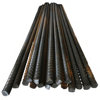Reinforcement
Rebar, or reinforcement bars, are essential in concrete and building work. These steel bars are embedded in concrete to enhance its tensile strength, making structures more durable and resistant to cracking. Rebar comes in various sizes and grades, tailored to specific construction needs. By providing additional support, rebar ensures the stability and longevity of buildings, structures, and other construction projects.
Showing 24 of 236 products
Types of Rebar
There are several types of rebar, each suited to different construction needs. The most common types include:
Carbon Steel Rebar
Carbon steel rebar is the most widely used type of reinforcement bar. It is known for its strength and durability, making it suitable for a wide range of construction applications. This type of rebar is typically used in residential, commercial, and industrial projects.
Stainless Steel Rebar
Stainless steel rebar is used in environments where corrosion resistance is crucial. It is more expensive than carbon steel rebar but offers superior durability and longevity, especially in harsh conditions such as marine environments or areas with high humidity.
Epoxy-Coated Rebar
Epoxy-coated rebar is carbon steel rebar that has been coated with an epoxy layer to protect it from corrosion. This type of rebar is commonly used in structures exposed to corrosive elements, such as bridges and parking garages.
Galvanized Rebar
Galvanized rebar is coated with a layer of zinc to protect it from corrosion. It is less expensive than stainless steel rebar and offers good corrosion resistance, making it a popular choice for many construction projects.
Benefits of Using Rebar
The use of rebar in construction offers several benefits, including:
Enhanced Structural Integrity
Rebar significantly improves the tensile strength of concrete, making structures more resistant to cracking and other forms of stress. This enhanced structural integrity ensures the longevity and safety of buildings and infrastructure.
Cost-Effective
While the initial cost of rebar may be higher than using plain concrete, the long-term benefits outweigh the costs. Rebar-reinforced structures require less maintenance and are less likely to suffer from structural failures, resulting in cost savings over time.
Versatility
Rebar is versatile and can be used in a wide range of construction applications, from building foundations and walls to bridges and highways. Its adaptability makes it an indispensable material in the construction industry.
Installation of Rebar
Proper installation of rebar is crucial to ensure its effectiveness. The process involves several steps:
Planning and Design
The first step in installing rebar is planning and design. Engineers and architects determine the type, size, and placement of rebar based on the specific requirements of the project. Detailed drawings and specifications are created to guide the installation process.
Cutting and Bending
Rebar is cut and bent to the required shapes and sizes using specialized tools and equipment. This step is essential to ensure that the rebar fits correctly within the concrete forms and provides the necessary reinforcement.
Placement and Tying
Once the rebar is cut and bent, it is placed within the concrete forms according to the design specifications. The rebar is then tied together using wire to hold it in place during the concrete pouring process. Proper placement and tying are critical to ensure that the rebar provides the intended reinforcement.
Pouring Concrete
After the rebar is in place, concrete is poured into the forms, encasing the rebar. The concrete is then allowed to cure, during which time it hardens and gains strength. The rebar and concrete work together to create a strong, durable structure.



































